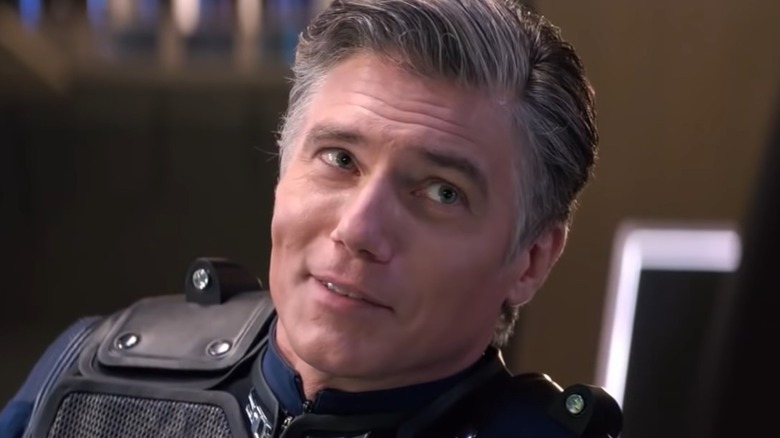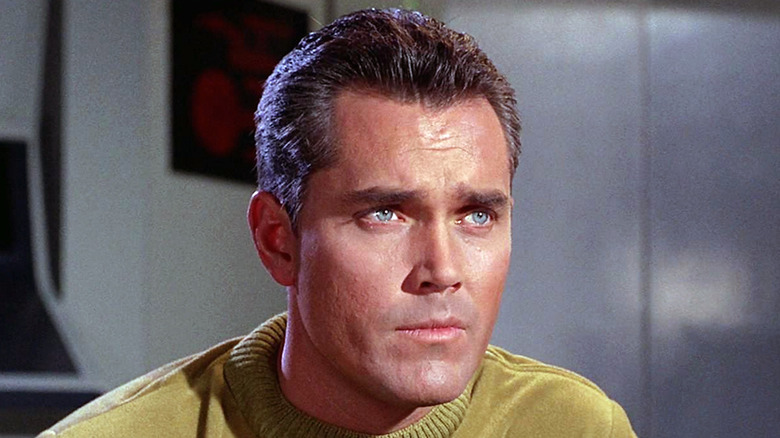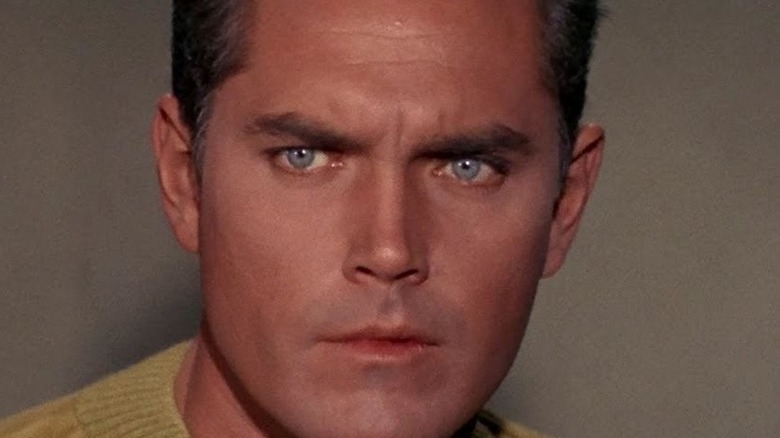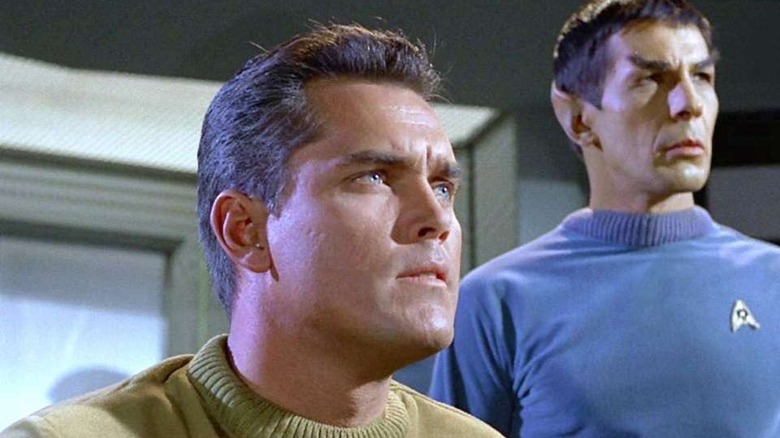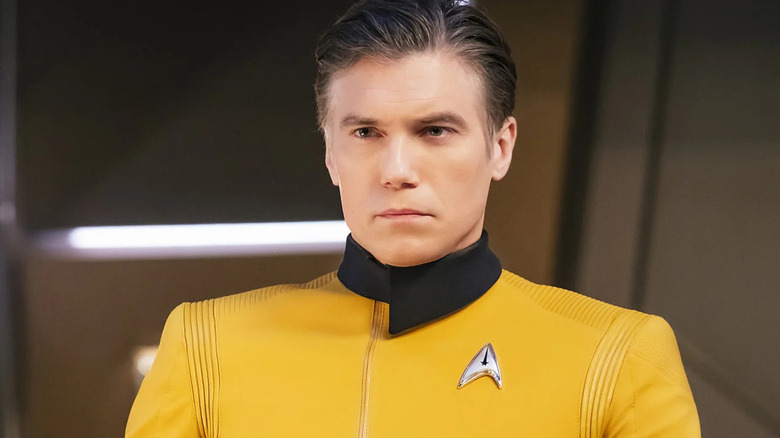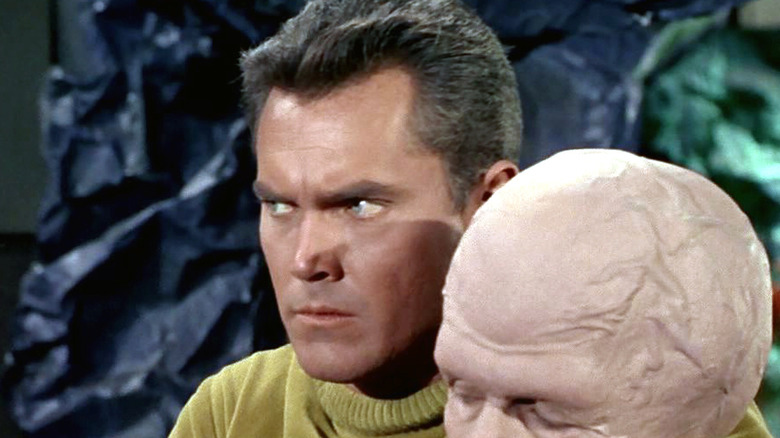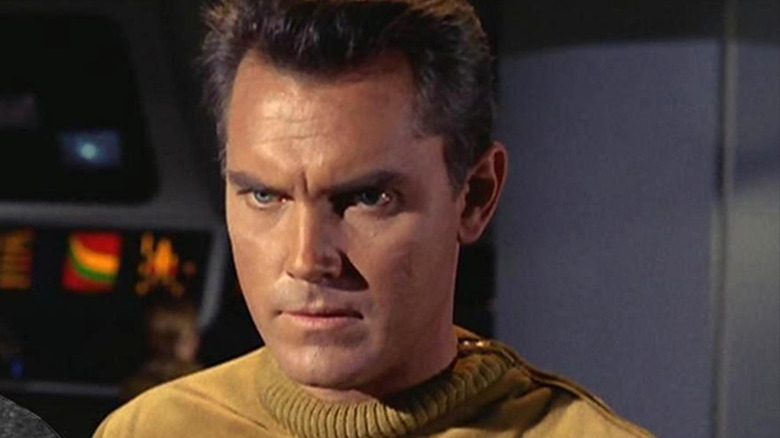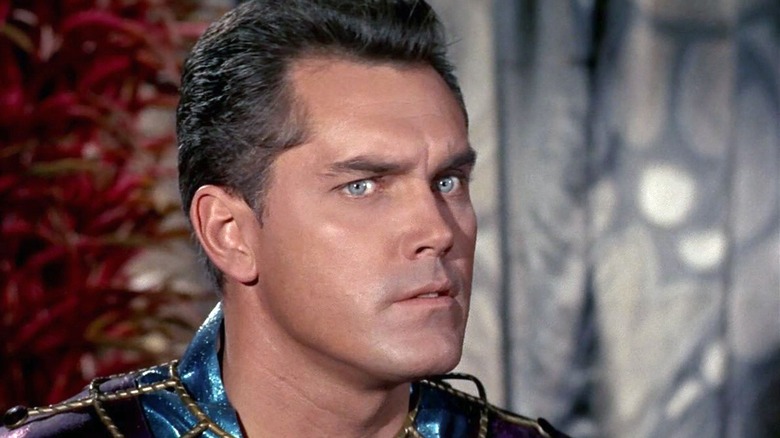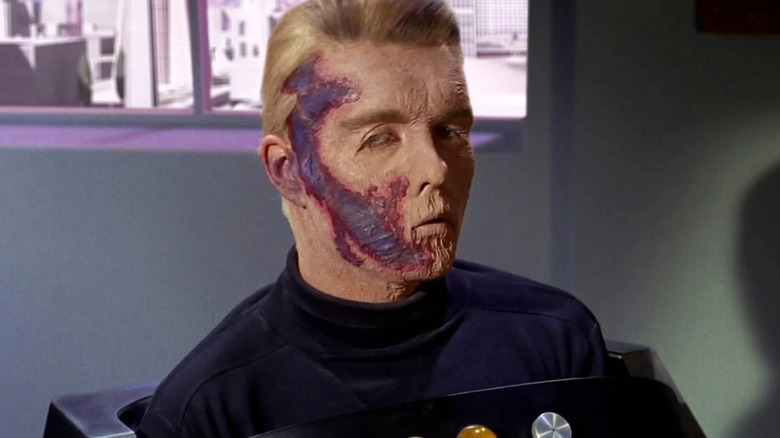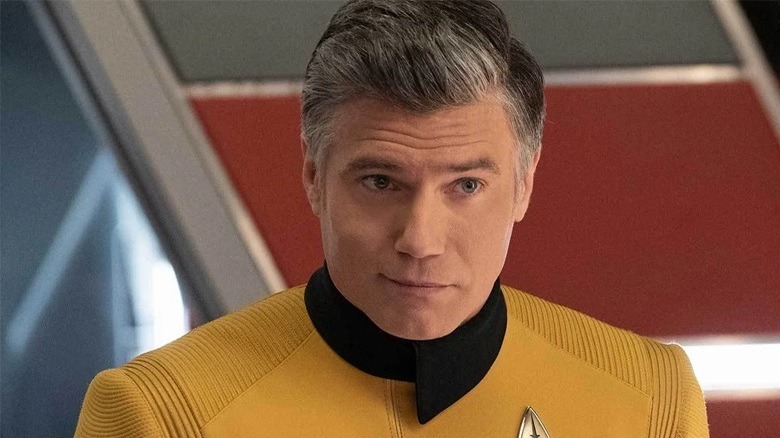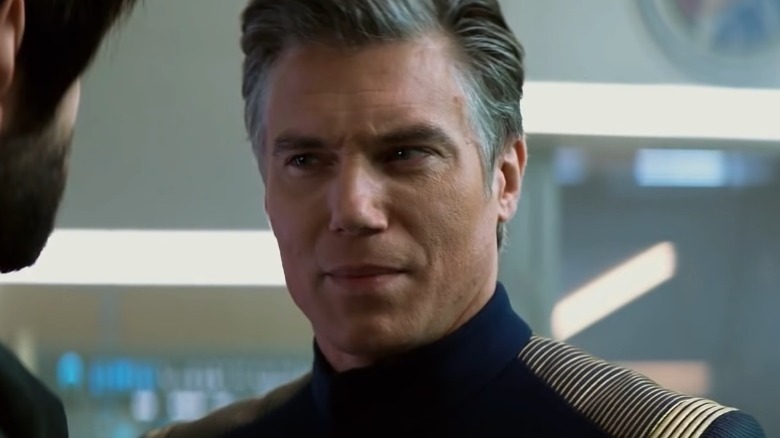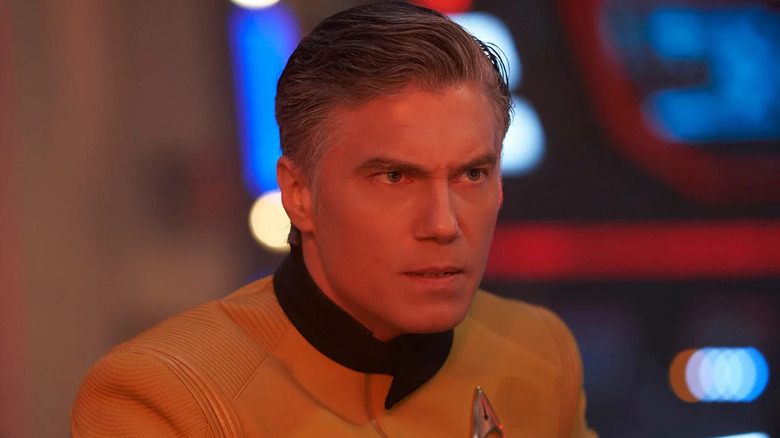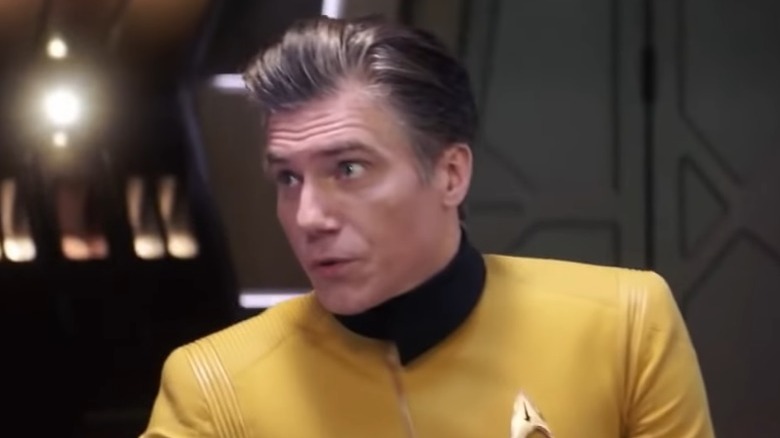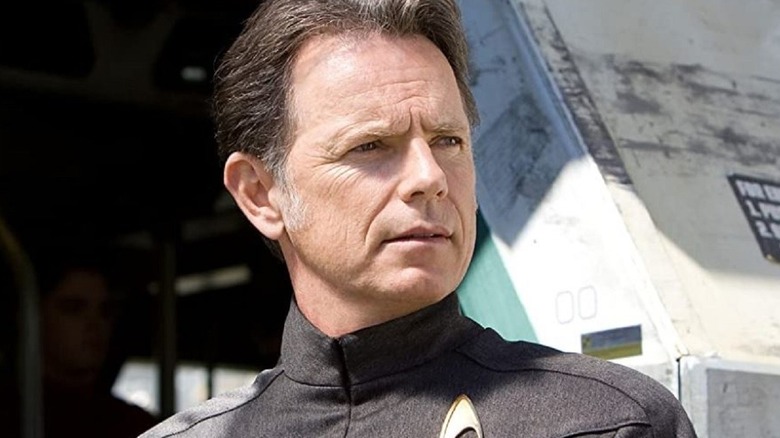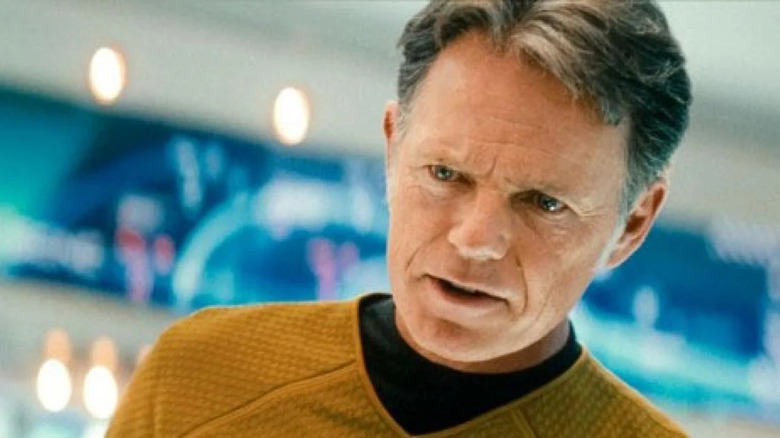The Untold Truth Of Star Trek's Captain Pike
"Star Trek" has been around for almost 60 years, and its captains, such as Kirk, Picard, and Janeway, are some of the most prominent faces of the series. However, the franchise's very first captain is hardly known at all to the general public. In fact, even some "Star Trek" diehards may know very little about him.
Captain Pike commands the Enterprise in the original series pilot titled "The Cage," which was filmed in 1965, and he takes the crew on their first mission in front of cameras. Unfortunately, the studio wasn't thrilled with the finished episode and chose not to air it. However, they felt that the show had potential, so they took the surprising step of green lighting a second pilot that aired the following year. In place of Captain Pike, we got Captain Kirk, who would lead the Enterprise — and the franchise — for the next 25 years.
Though an alternate version of Pike would have a part in the J.J. Abrams' "Star Trek" films, Pike wouldn't return to the series until 2019, in Season 2 of "Star Trek: Discovery." His arrival was so well received that the announcement of a series focused on the character, "Star Trek: Strange New Worlds," followed soon after. However, despite his handful of appearances, we still know very little about him. So we've raised our shields, set our phasers to stun, and assembled the untold truth of Captain Pike.
He was inspired by Horatio Hornblower
"Star Trek" creator Gene Roddenberry had always been a fan of Horatio Hornblower, the famous fictional sea captain and the protagonist in a series of novels by C.S. Forester. When creating "Star Trek," Roddenberry has acknowledged being inspired by these novels and explained that his captain was influenced by Hornblower himself: strong, skilled, and contemplative, but isolated from his crew.
While fans have long believed that the sea captain formed the basis for the second captain of the Enterprise, Kirk, it is Pike who has the most in common with Hornblower. In his pitch for the series, first revealed in 2011 and written years before he conceived of James T. Kirk, Roddenberry describes his captain as "a space age Captain Horation [sic] Horn-blower" within whom "lives a continual battle with self-doubt and the loneliness of command." Though the pitch would call the captain by a different name, it's the same character that would become Christopher Pike, as his description is much closer to what fans saw in that original pilot than would be displayed by the brash but gregarious Kirk.
Jeffrey Hunter was cast after an exhaustive search
The network bought Roddenberry's famous pitch that "Star Trek" would be a "'Wagon Train' to the stars," an outer-space version of the popular TV Western that saw cowboys traveling across an unexplored frontier, encountering exciting adventures week after week.
However, to make its first episode work, Roddenberry and the network needed a good-looking, charismatic leading man to star as captain of the Enterprise. Lots of names came to mind, but many were unwilling or unavailable. In "The Star Trek Interview Book," Roddenberry remembered that one of his top choices, Lloyd Bridges, turned down the opportunity, reportedly telling the "Star Trek" creator, "I've seen science fiction and I don't want to be within a hundred miles of it." Eventually, Roddenberry realized, "there just weren't a lot of actors who would do it. I was talking about what was in many people's eyes a silly show."
Other choices for Captain Pike are said to have included James Coburn, Peter Graves, and Robert Loggia, but it was movie star Jeffrey Hunter who surprised the studio with his interest. He was a controversial choice, but one the studio loved given his star power, and he would go on to become the series' first captain and a fan favorite once his work finally reached audiences.
Nobody knows for certain why Hunter didn't return
For a long time, it was assumed that Hunter departed the series after the initial pilot at the studio's behest. The thinking was that either some studio executive didn't like his portrayal or didn't feel he was right for the series. However, over the years, quotes from various people involved with the production of "Star Trek" have cast a different light on the situation, sometimes offering contradictory versions of the events that lead to his departure.
Hunter's replacement, William Shatner, recalled in the book "Star Trek Memories" that Hunter was actually fired because his wife, who had suddenly become highly involved in the project, was making unreasonable demands on her husband's potential return for a full series. Leonard Nimoy would repeat this claim in his 1995 book "I Am Spock." On the other hand, some have said that Hunter wasn't fired at all, but quit to return to roles in feature films, not wanting to commit to a weekly television series that might have prevented him from pursuing bigger work. Still others have said it was a simple contractual issue, that he had no provision for a second pilot, and wanted to renegotiate. The website Star Trek Fact Check chronicled the different stories in 2013. Whatever the truth may be, fans will likely never know all of the details, as Hunter died tragically from complications from surgery after a fall in 1969.
He wasn't the first captain of the Enterprise
Despite being the first "Star Trek" captain to go before cameras, Pike wasn't the first captain of the Enterprise. In fact, we've since learned that the ship is actually more than 20 years old, and its first captain was a man we still have yet to meet in live-action.
However, fans have had a chance to see him in animated form. In the short-lived "Star Trek: The Animated Series," the ship's original captain appears in the episode "The Counter-Clock Incident." The 1974 episode reveals that Kirk is actually the ship's third captain, after Pike and a man named Robert April, who comes back aboard the Enterprise in that episode as a Starfleet Commodore. Robert April is actually the same name Roddenberry had used for his captain in his original pitch, and he brought it back for the animated episode as an homage to his original concept. That said, the existence of Captain April has always been controversial among Trekkies since "The Animated Series" is considered by some to be non-canonical, but that's where "Star Trek: Discovery" comes in. In the episode "Brother," we learn that Captain Pike took command of the Enterprise from the outgoing Captain April years earlier when he was promoted from his position as April's first officer.
Pike's first episode was chopped up and became his second
According to "The Center Seat: 55 Years of Star Trek," the original pilot episode "The Cage" cost nearly $600,000 to produce. The fact that the network chose not to air it and instead try a second pilot is a testament to both the quality of the concept and the studio's belief that it could be the network's next big hit.
However, they weren't going to allow all the footage they'd shot to go to waste. So Roddenberry put together a two-part episode titled "The Menagerie" that would be able to recycle much of the original pilot cut around new scenes of Spock reminiscing about an earlier adventure. In the episode, Spock steals the Enterprise to transport a now-disfigured Captain Pike to a planet called Talos IV — a world that Starfleet has deemed off-limits, under penalty of death. Spock fails and is put on trial, during which he recounts the events of "The Cage." It's one of the series' more memorable episodes and shows Spock and the Enterprise as having an exciting depth and history, something that always made "Star Trek" unique. Of course, at the time, viewers had no idea that the flashback scenes were from an unaired episode, as they wouldn't discover the existence of "The Cage" for many years.
His first episode only aired once, 22 years after it was filmed.
The making of the original "Star Trek" pilot "The Cage" has been well chronicled, and the History Channel documentary "The Center Seat: 55 Years of Star Trek" does a great job of outlining how the episode came together. However, what's lesser known is what happened to the footage captured for "The Cage" after it was rejected.
Supposedly, the master print of "The Cage" was cut up and spliced directly into the 35mm print of "The Menagerie," while the unused parts were discarded. It's well known that Roddenberry kept a black and white print for himself that he showed at conventions, but the original full-color episode was lost. In 1986, to commemorate the 20 year anniversary of the series, a VHS release of "The Cage" was produced, assembled from the color segments from "The Menagerie" and filled in with Roddenberry's black and white print, and this was the first glimpse of the unseen pilot for most fans.
The following year, however, a film archivist named Bob Furmanek unearthed the original 35mm color negatives in a Hollywood film lab and transferred them to Paramount, who now owned "Star Trek." Thanks to this discovery, a special full-length, full-color presentation of "The Cage" aired in 1988 as part of a two-hour special called "The Star Trek Saga: From One Generation To The Next." It was the first — and only — time that "The Cage" would be broadcast on television.
Pike only appeared in two episodes before 2019
Even though the Enterprise's first on-screen captain, Pike, has a long canonical history, he only ever appeared in the original pilot, "The Cage," and the Season 1 episode "The Menagerie," which featured snippets of reused clips from the unaired episode. During the 1970s, the only way to see the unaired pilot was to attend one of creator Gene Roddenberry's appearances at "Star Trek" conventions, where he would delight the crowd by playing the episode for audiences, as was reported at the time by the San Antonio Express. Back in those days, long before the internet, the opportunity to see a secret episode of their favorite show was a once-in-a-lifetime opportunity, and it helped the legend of Captain Pike grow.
Surprisingly, despite his importance to the history of the franchise on and off the screen, the character of Captain Pike would get minimal mention over the next several decades. It wouldn't be until 2019, over 50 years after "The Cage" was filmed, that Pike would return. After a brief reference on a computer display in the "Star Trek: Discovery" episode "Choose Your Pain," Season 1, which is set 10 years before the original "Star Trek," would end with the arrival of a pre-Kirk Enterprise. In the Season 2 premiere, "Brother," fans finally got to see Pike command a starship once again.
Pike was disfigured so a different actor could play him
Gene Roddenberry knew that the chances of getting Jeffrey Hunter to return to film "The Menagerie," which resued clips from Hunter's unaired pilot, were remote, so drafts of the episode described Pike as a frail man who could hardly speak. When the actor formally declined an offer, it became necessary to recast, and a new search began for a replacement.
It wasn't easy to find a new captain, as Gene Roddenberry took the casting of the relatively small part incredibly seriously. The role of the injured Captain Pike ultimately went to Sean Kenney, an actor nearly half Hunter's age. Kenney recounted the story of his casting in his book "Captain Pike Found Alive!" where he shared how Roddenberry described the role to him in a meeting. Kenney wrote, "[he] said that the lead character, Pike, had been severely injured in a training accident and was unable to speak or move any body parts. Much of this role would come from emoting feeling through my eyes." Told by Roddenberry that he would be under heavy makeup to appear injured and older, Kenney was confused, "I'm thinking, why me, why don't they just get an old guy?" Regardless of his bewilderment, Kenney accepted the role without hesitation.
He lived out his final days on Talos IV
The plot of the two-part "Star Trek" episode "The Menagerie" sees Spock attempt to take a disfigured and mute Captain Pike to the planet Talos IV, the same world featured in the unaired pilot episode "The Cage." It was an effort to allow Pike a semblance of a normal life because the Talosians were powerful telepaths with the ability to create completely realistic illusions. In "The Cage," they grant a disabled woman the ability to live a normal life and give her all the comforts she could ever want. If Spock could bring Pike back to Talos IV, perhaps the Talosians could do the same for him, as he now uses a futuristic wheelchair and is unable to speak.
At the conclusion of "The Menagerie," Spock, with the assistance of Captain Kirk, is able to persuade Starfleet Command to lift the ban on a visit to Talos IV. This allows Pike to live out the remainder of his life with dignity, in recognition of his service to the Federation. In the final scene of the two-part episode, Pike reverts to his more youthful, vigorous appearance as he bids goodbye to his former science officer.
Pike knows his future
Plenty of characters in the "Star Trek" universe have met a dark fate. Kirk dies at the hands of a planet-killing terrorist in "Star Trek: Generations" while Spock is lost forever inside a black hole in J.J. Abrams' film "Star Trek." However, Captain Pike, who commands the Enterprise on "Star Trek: Discovery," will not only wind up disfigured, mute, and exiled to an alien world due to a terrible accident and, but he is also well aware of his unfortunate future.
In the "Star Trek: Discovery" episode "Through the Valley of Shadows," Pike ventures to the Klingon world of Boreth, where a sect of secretive monks reside. Once there, he must retrieve a time crystal that will allow him to send the U.S.S. Discovery far into the future, averting a potential galactic disaster. However, accessing the time crystal comes with a terrible price — a vision of his future.
What's worse, nothing he sees is truly set in stone unless he chooses to take the crystal. Once he removes the crystal from Boreth, the future he sees will become his fate, as unavoidable as tomorrow's sunrise. While horrified by the future that he observes, Pike still chooses to retrieve the crystal, knowing that it may be the key to saving the entire galaxy.
He has a Starfleet commendation named after him
Captain Pike isn't just a legend to fans of "Star Trek." He's also a legend to his fellow Starfleet officers. In addition to having Pike City on Cestus III named in his honor, he becomes one of the most famous Starfleet captains, even in his own time. In the "Star Trek: Discovery" episode "Choose Your Pain," Commander Saru tells the computer to display the names of the fleet's most decorated captains. The list the computer produces includes Robert April (the first captain of the Enterprise before Pike), Jonathan Archer (captain of the NX-01 on "Star Trek: Enterprise"), Matt Decker (from the original series episode "The Doomsday Machine"), and, of course, Pike himself.
The long list of commendations that Pike has received features the Starfleet Medal of Valor, the Legion of Honor, the Star Cross, the Medal of Commendation the Starfleet Silver Palm, and the Legate's Crest of Valor, among many others. With so many medals to his name, perhaps it should come as no surprise then that Pike would later have an award named after him with the Christopher Pike Medal of Valor. In "Star Trek: Deep Space Nine," Captain Sisko receives the Pike Medal of Valor for his actions at the Battle Of Deep Space 9, the mission that reclaimed the station from Dominion takeover in the episode "Tears Of The Prophets."
Pike was sidelined for the Klingon War
The war between the Klingon and the Federation has been vaguely referenced for years in "Star Trek," and fans finally got to see some of it play out in Season 1 of "Star Trek: Discovery." The series shows Burnham instigating the first major engagement between the two galactic powers in "The Battle Of The Binary Stars." You might think that Captain Pike, as one of the most decorated captains in Starfleet, would become one of the war's greatest human heroes — but you'd be wrong. Instead of taking the Enterprise to the front lines, Pike, Spock, and their crew sit out most of the war.
As Pike says in the episode "Brothers," the Enterprise is in the midst of a five-year exploratory mission outside Federation territory when the war breaks out. Instead of being ordered back to fight, he is ordered to stay on his mission. For this exalted Starfleet hero, it is frustrating to sit on the sidelines while the fleet risks everything in a war that could decide the very future of the Federation. When viewers meet him following the conclusion of the war in the opening of Season 2 of "Star Trek: Discovery," Pike feels a kind of survivor guilt, having been unable to contribute to the war effort. He's itching to get back into the action and jumps at the chance to take command of the U.S.S. Discovery on a vital mission with galactic consequences.
Pike has been played by four actors
Despite being written into just a single official television episode during the franchise's first 40 years, Pike has surprisingly been portrayed by four different actors. In the unused pilot "The Cage" and the flashback scenes of the original series episode "The Menagerie," which featured clips from the unaired episode, Pike was played by Jeffrey Hunter. After Hunter declined an offer to reprise the role in wraparound scenes in "The Menagerie," a disfigured Pike was portrayed by actor Sean Kenney.
When J.J. Abrams rebooted "Star Trek" in 2009, they took the once minor character of Pike and gave him a much more significant role as the Enterprise captain who recruits a young Kirk into Starfleet. This version of Pike was played by actor Bruce Greenwood, who imbued Pike with gruff intensity. In "Star Trek: Discovery," Pike returns to the small screen, now played by "Hell on Wheels" actor Anson Mount, who impressed critics and viewers alike. Even those critical of "Star Trek: Discovery" on forums such as Reddit called him a bright spot of Season 2. Pike next appears in "Star Trek: Strange New Worlds," a series about the adventures of a pre-Kirk Enterprise, perhaps finally fulfilling the original vision Gene Roddenberry pitched decades ago.
Pike is dead in both major alternate timelines
Like Marvel's multiverse, there's an endless number of parallel realities in "Star Trek" lore. However, two alternate realities have dominated the franchise. These are the so-called Mirror Universe that first appeared in the original "Star Trek" episode "Mirror, Mirror," and the alternate universe seen in the J.J. Abrams films, which is created when Romulan villain Nero travels back in time to kill Spock.
However, in both of these realities, Pike is killed relatively early on. When Kirk is transported into the Mirror Universe, he has no knowledge of this alternate reality, so he looks up the history of this new universe in the ship's computer. To his surprise, Kirk discovers that his variant counterpart had assassinated the ship's former captain, Christopher Pike, and took his place as captain of the Enterprise. In the J.J. Abrams films, where he has since been promoted, Admiral Pike is killed early on by Khan in the sequel film, "Star Trek: Into Darkness." Of course, this is science fiction, so in addition to showing adventures set before their deaths, resurrecting these parallel Pikes through any number of methods is not out of the question. As such, it's possible we haven't seen the last of these versions of Captain Pike, either.
